Ultrabook Head to Head: Acer Aspire S3 vs. ASUS UX31E
by Jarred Walton & Manveer Wasson on December 21, 2011 5:40 AM ESTNetbook Levels of Battery Life
When netbooks came on the scene, they made the idea of a $1000+ ultraportable seem rather laughable. Several years later we’re rebranding ultraportables as ultrabooks (provided they have Intel Inside) and giving it another go. Of course, ultrabooks pack a few tricks like SSDs for better battery life and performance, and Intel’s ULV Sandy Bridge processors are proving to be very efficient when it comes to saving power. We ran our usual suite of battery life tests, with the LCDs set to as close to 100 nits as possible (50% brightness on the Acer S3 and 18% brightness on the ASUS UX31E).
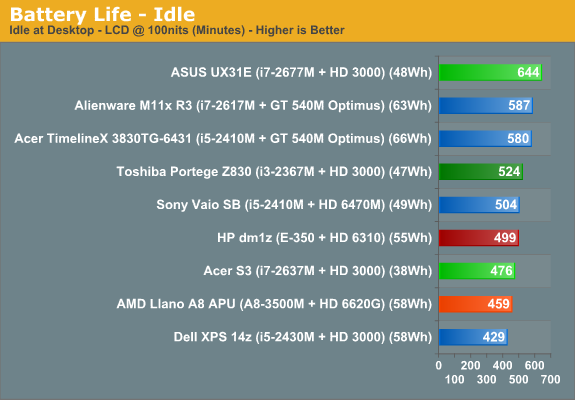
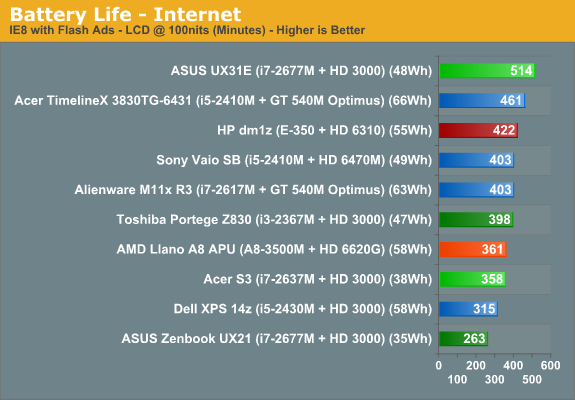
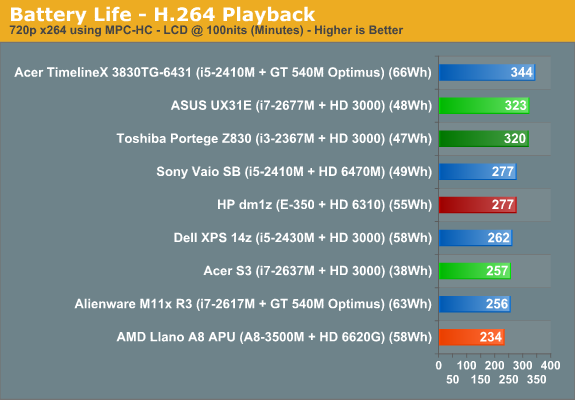
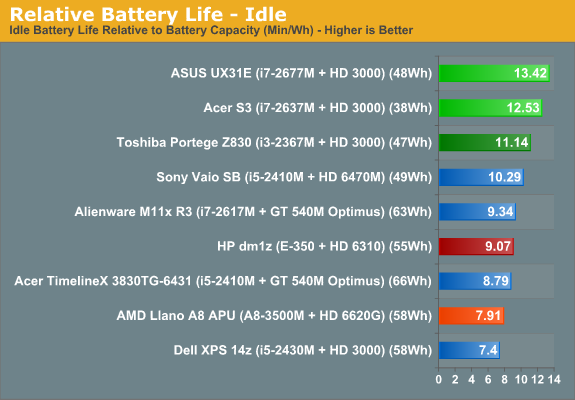
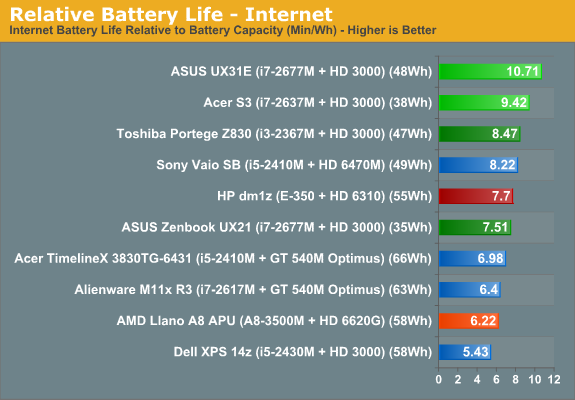

The Acer has a much smaller 3-cell battery, but even with a 38Wh capacity it still boasts respectable battery life of over four hours of H.264 playback and nearly eight hours of idle time. Switch over to the UX31E and not only do you get a higher battery capacity, you also get apparently better power optimizations. In our H.264 test the ASUS “only” manages close to 5.5 hours of playback, while it jumps to 8.5 hours of Internet surfing and over 10.5 hours of idle time. Look at the relative battery life charts and the results are even more impressive: the three ultrabooks we’ve reviewed place at the top of the charts, and even if we compare with Atom, the UX31E matches and sometimes exceeds what the best netbooks could achieve; the other two ultrabooks where we’ve done full reviews also place near the top of our relative battery life charts.
Something else we tested that we don’t have in the above charts is idle battery life with the LCD at maximum brightness. The Acer drops to 400 minutes, but then it only gets about 120% brighter as we’ll see on the next page. The UX31E on the other hand does a swan dive down to just 357 minutes, but you have to take into consideration the 450% increase in brightness. Put another way, power draw for the Acer is around 4.7W at 107 nits (50%) and 5.59W at 234 nits (100%); the ASUS on the other hand uses 4.38W at 93 nits (18%) and jumps up to 7.91W at 519 nits (100%). Even though that’s a pretty big jump in power use, we still have to credit the LED backlighting technology: 500+ nits for less than 5W of power isn’t really that bad.
The short summary here is that you may have to pay more, but you do get substantially better performance than a netbook, you don’t sacrifice much in the size or battery life departments, and build quality is generally far higher than inexpensive laptops and netbooks. Does that make ultrabooks a better option than other laptops? Not for everyone, but there are certainly people that will like what ultrabooks have to offer.










81 Comments
View All Comments
icrf - Thursday, December 22, 2011 - link
I think the problem is thin laptops are designed to be portable, and 17" laptops of any thickness aren't nearly as portable. If you have a bag/case big enough for a 17" chassis there is usually plenty of room for something much thicker than an inch.Lighter weight, however, is good pretty much everywhere.
Sufo - Friday, December 23, 2011 - link
Well there's always the razer blade... lolJojoKracko - Thursday, March 15, 2012 - link
Yes, I'd also like a 15 or 17 inch ultrabook. But it would have to have a better screen than these come with.Fortunately there is some hope that the manufacturers are coming to their senses. The UX31A will have a 1080P Matte IPS screen.
Now just create a 17 inch version with a numeric keypad (full width zero key please) and I'll be happy.
popej - Wednesday, December 21, 2011 - link
Thanks for review!Some doubts:
- Does contrast measurements include ambient light reflection? If not, results could be far form real life experience. I'm afraid that flowed test leads to flowed design, where manufactures try to get best tests results instead of best usefulness.
- Are battery life test comparable between units? I have doubts about Internet test. One of the tricks that Asus is using is to reduce CPU speed when on battery. This way battery last more but quality of work is reduced. I would prefer a test, where amount of work done is measured, not only time.
- Can this notebooks be comfortably used outdoor? I would expect this possibility from a ultra portable device. But none of your test gives a clear answer.
Kepe - Wednesday, December 21, 2011 - link
Jarred mentions twice in this article that the Asus unit can be used outside thanks to its bright display.JarredWalton - Wednesday, December 21, 2011 - link
The ambient light will affect the perceived brightness from the display (brighter environment means you'll want the LCD backlight turned up), and perceived contrast with reflections will also be affected. For the test, we place a colorimeter on the display and measure the white level and black level; divide the two and that's your contrast. I'm not sure what would be flawed with that approach, though in practical use other variables (that can't really be tested) come into play.The battery life tests are all performed at equivalent settings. That means Power Saver profile (or Power4Gear Maximum Battery on the ASUS). Then we make sure maximum CPU speed is set to 100% while minimum speed is 5%. The displays are also calibrated to the same ~100 nits brightness, and we run a loop where the web pages are loaded every 60 seconds in a repeatable manner. For most Internet surfing, this is far more important than quantity of work completed -- you read a web page that loads in a couple seconds; rarely do you actually run a continuous load for surfing, particularly on a laptop that's running off its battery.
On the other end of the spectrum, the H.264 playback is a continuous load of video decoding, so your real-world battery life will generally be more than that and less than the idle, but where you fall naturally depends on what you're doing.
popej - Wednesday, December 21, 2011 - link
Colorimeter measurements would be equivalent of using notebook in a dark room, where anti-glare coating has no relevance. I think that easy way to check practical contrast could be done with digital photography using picture raw data for analysis.I don't know Power4Gear but quick search in net indicate, that "Maximim battery" could mean underclocking CPU, thus no 100% speed. So there is no superior efficiency but simply different settings.
twotwotwo - Wednesday, December 21, 2011 - link
I'm with papaj on ambient light. You can't tell exactly what conditions users will work in, but these numbers are based on _zero_ ambient light, not the most common use case (though it is a real use case, e.g., watching a movie in a dark room). And it makes black levels very important to the contrast ratio and anti-glare not important at all.I get that it's kind of hard to factor reflections in and, frankly, you guys already do a ton of tests on a ton of systems. Also, initially you wouldn't have lots of other recent devices' numbers for comparison as you do for ambient-light-free contrast numbers. I didn't even know until today (via a DisplayMate comparison) that the reflection strength was something that was measured or that it varied so widely, but knowing it, I'm pretty curious about "real," everyday contrast numbers.
Some kind of "indoor contrast ratio" figure would be interesting, using black and white levels on the current colorimeter figures + (reflection strength * a standard assumed level of light indoors). Even bare reflection strength numbers would be interesting, as I'm sure readers vary in what they think about display shininess. :)
twotwotwo - Thursday, December 22, 2011 - link
Whoof, just peeked at the VESA standards for measuring reflectance. I'm amazed that anyone does any of those tests now.QChronoD - Thursday, December 22, 2011 - link
I would like to see the contrast ratio of the Asus measured when its at ~100 nits as well. The 500 nits would be useful if one wanted to use the laptop outside, but I would guess that the vast majority of the time it would be used indoors. Would it be possible to measure the Asus' screen at the standard brightness? If nothing else, the black levels wouldn't be washed out, and it would probably look better.